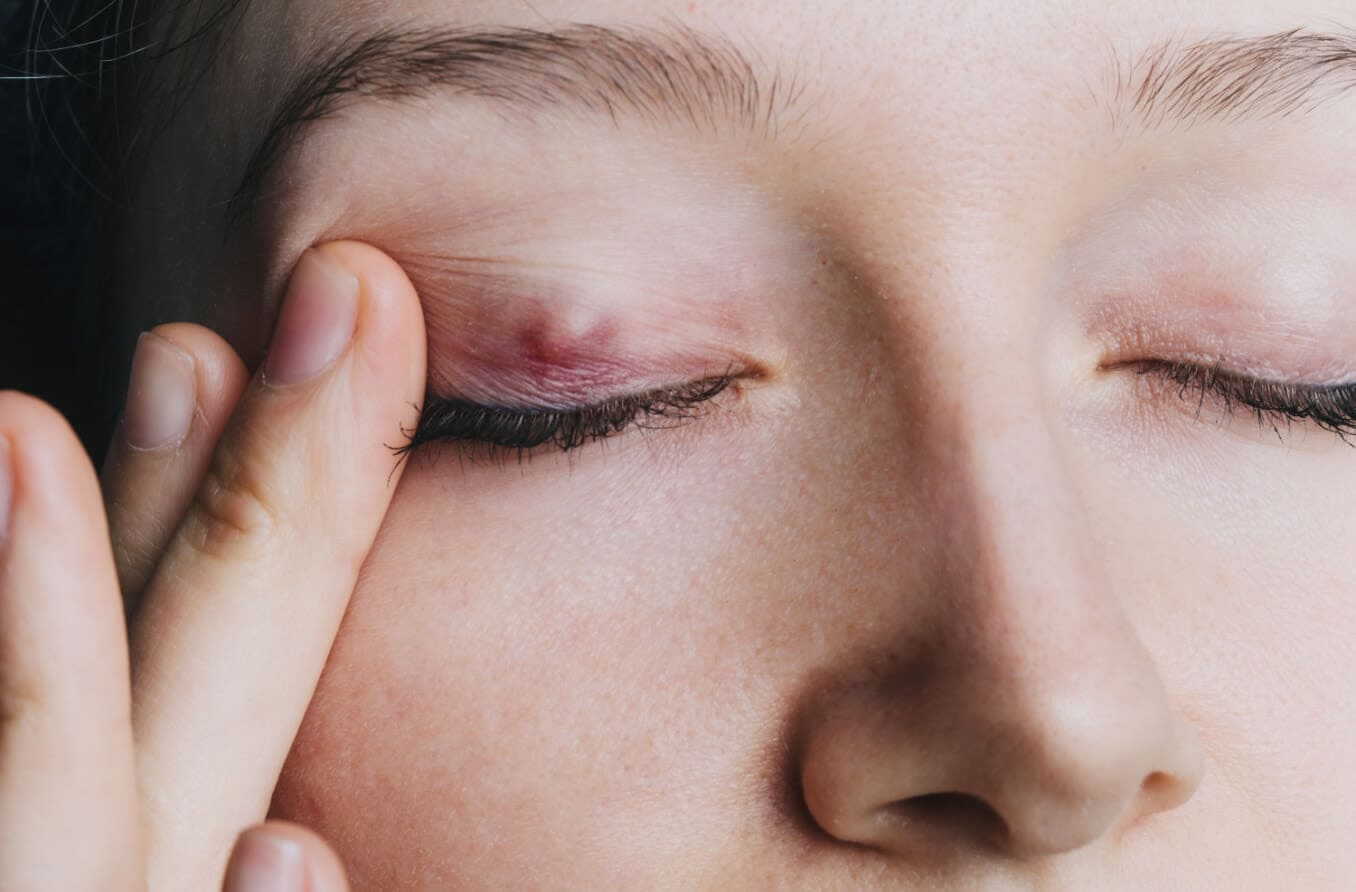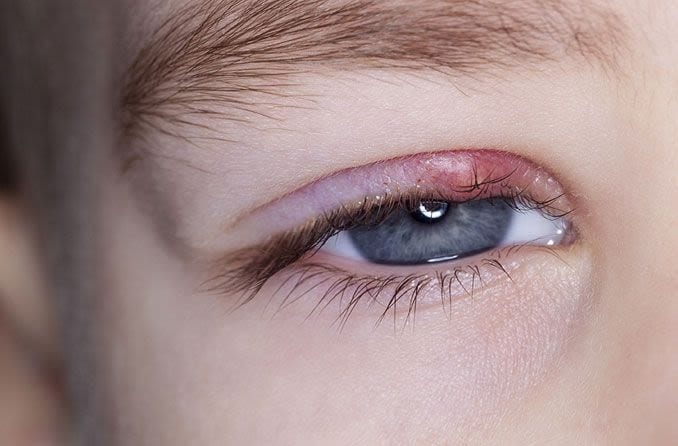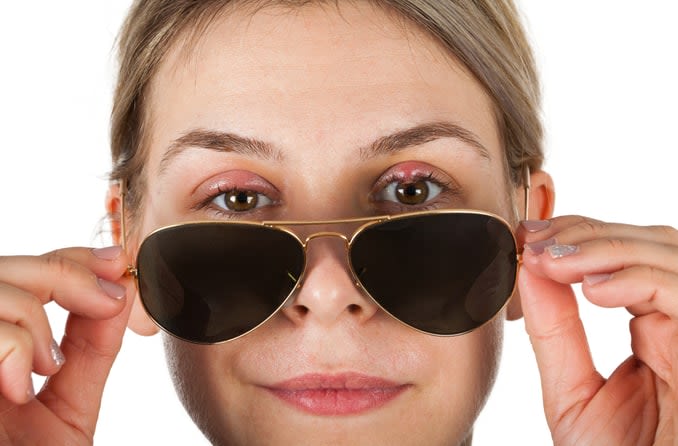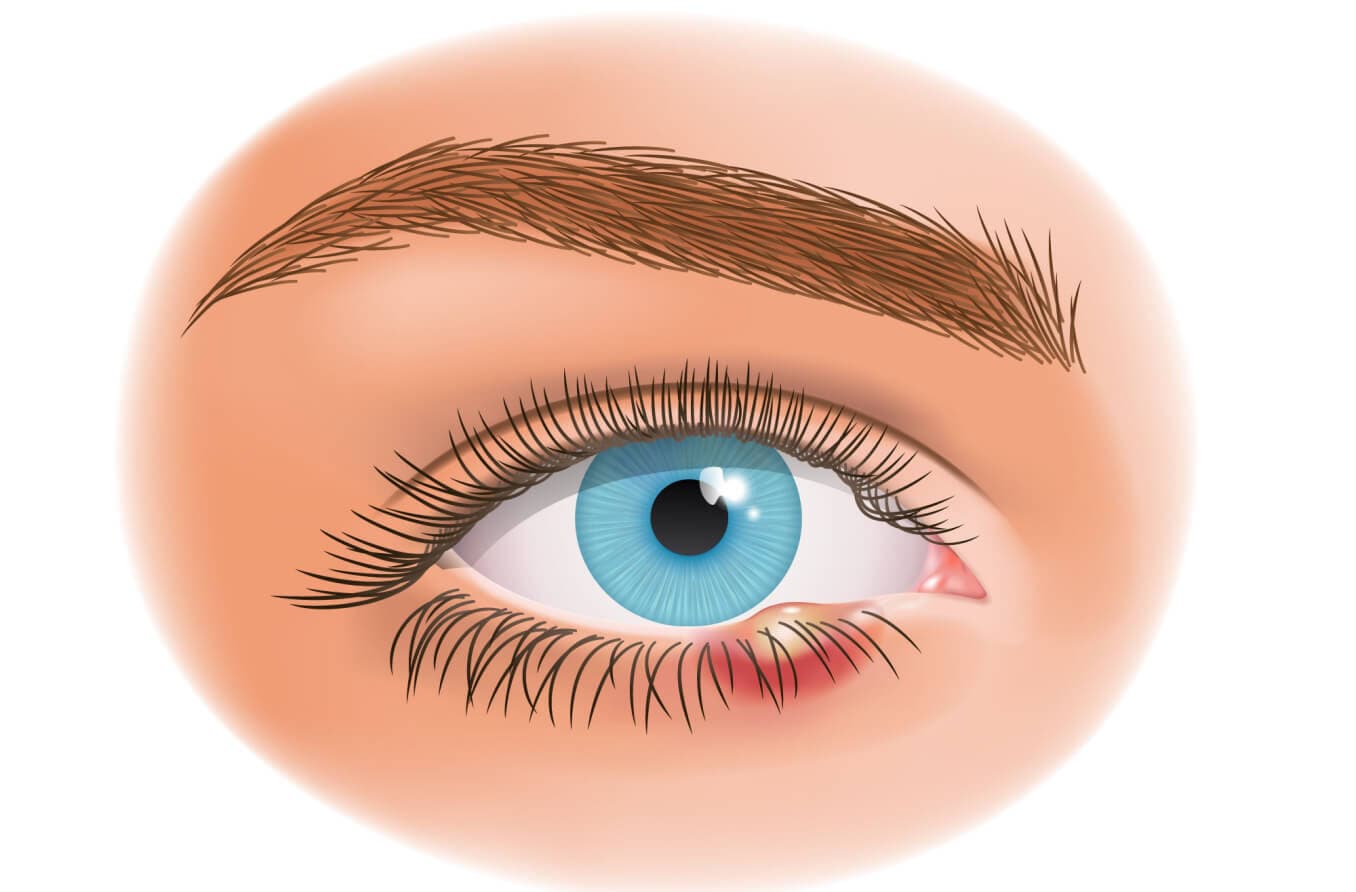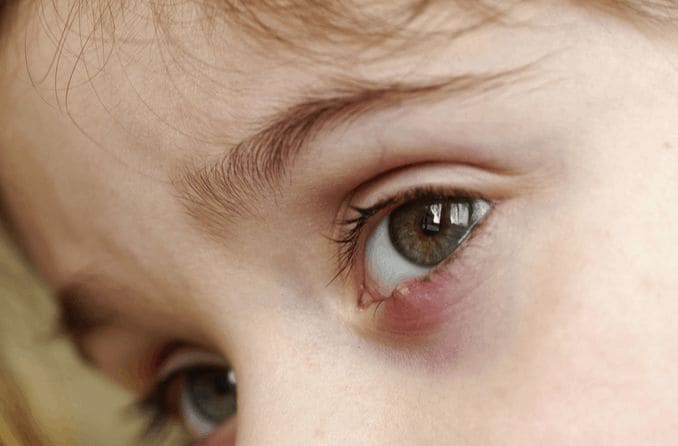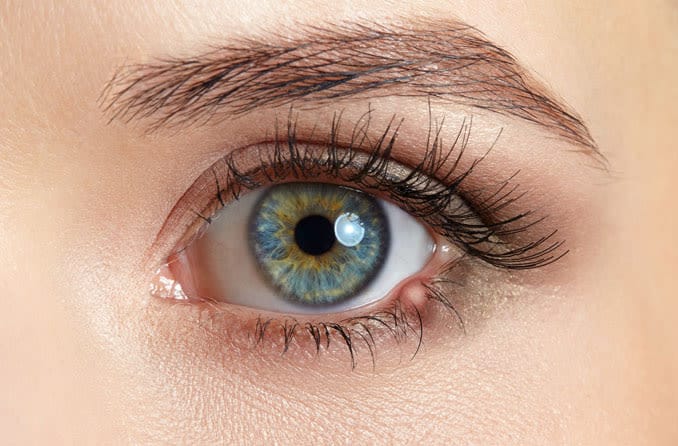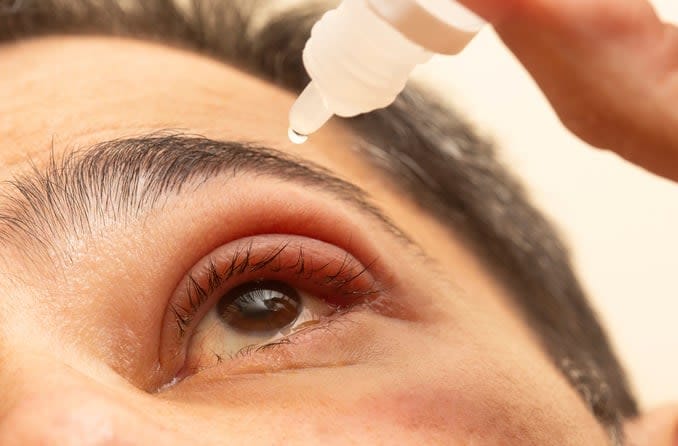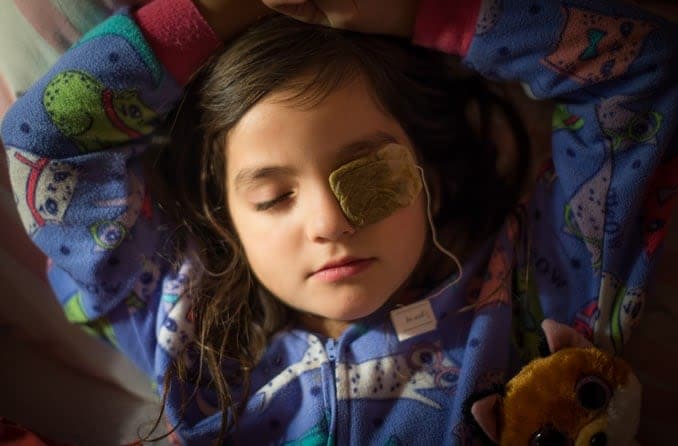What are chalazia?
A chalazion is a type of internal eyelid cyst. Also called meibomian cysts, they form when oil glands inside the eyelid called meibomian glands become clogged. Most are painless, but they can grow to be pea-sized and last for several weeks. Some chalazia can grow large enough to disturb vision.
A chalazion (kah-LAY-zee-on or shah-LAY-zee-on) looks like a lump or bump under the eyelid. The clogged gland is on the inside surface of the lid, so there is usually no external lesion.
Chalazia (kah-LAY-zee-uh or shah-LAY-zee-uh) can form in the upper or lower eyelid, but they are most common in the upper lid. The lump is usually a little above the lash line (on the upper eyelid) or below the lash line (on the lower eyelid). The lump is not typically in the lashes.
Chalazion vs. stye (hordeolum)
Chalazia and styes are similar types of eyelid bumps, but they aren’t the same thing.
A chalazion forms when a specific type of gland inside the eyelid, a meibomian gland, becomes clogged. The fatty secretions (lipids) produced by these glands normally help lubricate the eye, but they can no longer drain out. This blocked material eventually becomes a rubbery cyst inside the gland. A chalazion (or meibomian cyst) is not an infection.
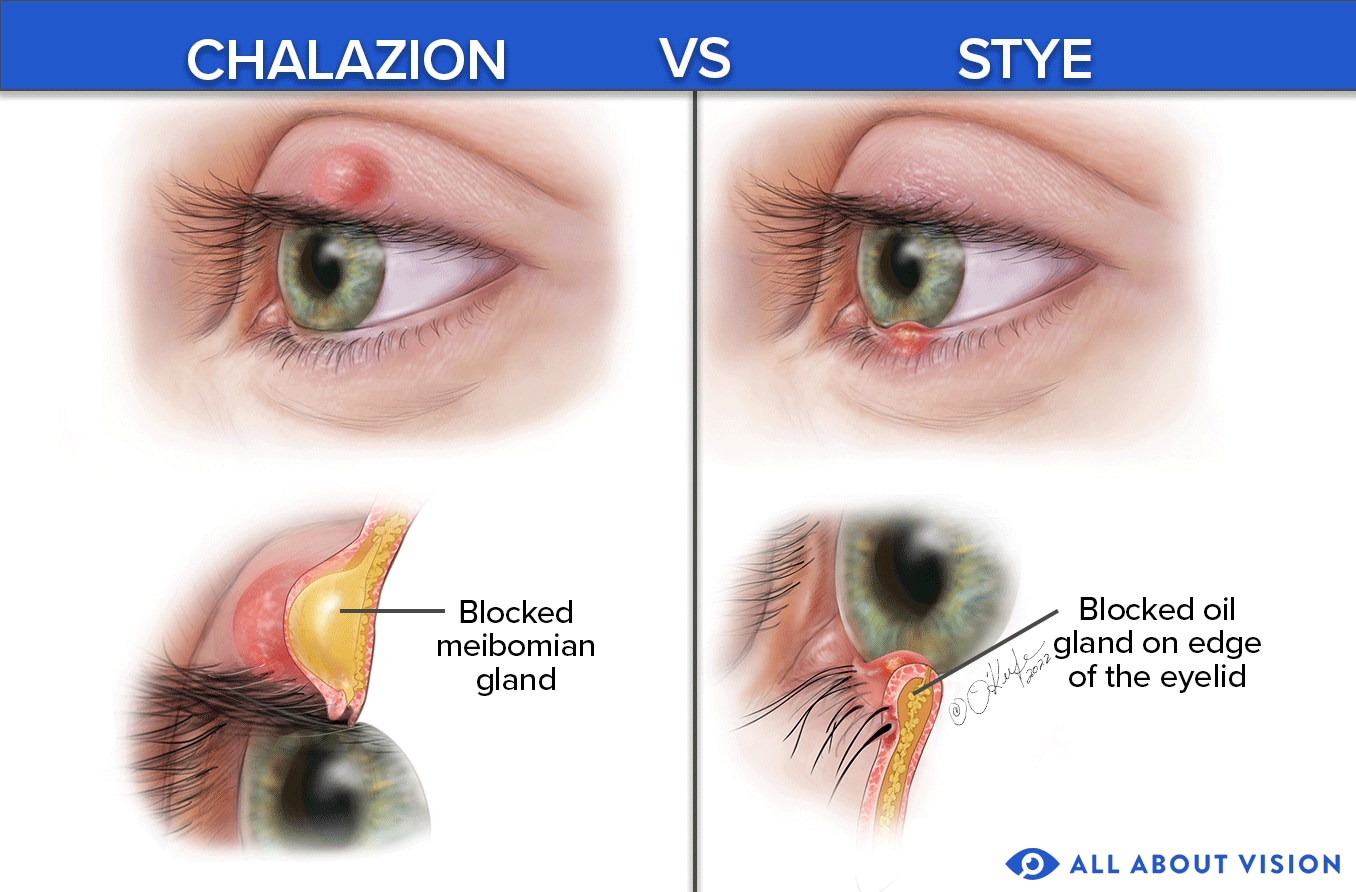
Illustrated by Laurie O'Keefe
Styes (hordeola) are also caused by clogged glands, but they are clogged glands that become infected rather than forming cysts. This happens if bacteria are trapped inside along with the oils, dirt and debris blocking the gland.
Styes can develop internally, in meibomian glands, or externally, in oil glands in the eyelash follicles. External styes are much more common than internal styes and chalazia. However, an internal stye can sometimes turn into a chalazion once the infection is gone if the gland fails to drain.
Styes are often painful, but they heal quickly — within just a week or two. Chalazia do not usually hurt, but they last a lot longer. A chalazion may last several weeks, even with medical treatment.
LEARN MORE: Parts of the eyelid and how they work
Chalazion symptoms
When a chalazion begins to form, the first symptoms most people experience are eyelid swelling and some mild pain or tenderness. Less commonly, the swelling can be more severe and painful — or there may be no initial swelling at all.
This first stage typically only lasts a couple of days. As the swelling goes down, a small, red, painless lump under the skin will begin to form or become noticeable. Usually, the cyst will grow slowly over the course of a week or so and then stop growing.
However, some do continue growing and become larger. It’s also possible to have more than one at a time. A meibomian cyst can last several weeks, and sometimes months, before going away on its own. Some are very stubborn and last until they are surgically removed by an eye doctor.
While the cyst lingers, it may cause some other symptoms, including:
- Foreign body sensation
- Eye itchiness
- Increased watering or tearing
These symptoms are mainly due to the eye being drier than normal. When a meibomian gland is blocked, this can reduce the quality of the tear film that usually keeps the eye moist. Less oil released from these glands causes the tear film to evaporate too quickly.
Dry eyes can feel itchy and like something is “stuck” in them. Dry, irritated eyes can also become extra watery or teary. This happens if they overproduce tears to make up for the poor tear film or to try to flush out whatever is irritating them.
Less often, a meibomian cyst can also cause these symptoms:
Blurry or blocked vision – Meibomian cysts typically range from 2 mm to 8 mm across, but they can be larger. For reference, the edge of a US nickel is about 2 mm thick. An average pea is 8 mm to 10 mm.
When a chalazion grows to around 5 mm or more, it can push against the surface of the cornea. This distorts the shape of the cornea and causes blurry vision that is similar to having an astigmatism. The is only temporary, though, and goes away when the chalazion resolves or is removed.
A large meibomian cyst may also partially block vision. It may block some peripheral vision just by its sheer size. It is also possible for a cyst to become large enough to cause the eyelid to droop (called ptosis) and block vision.
Visible or external lesion – It is rare, but a chalazion may develop into an external lesion.
Most meibomian cysts will either burst and drain from the inner eyelid or will be naturally absorbed by the body. But in some cases, a cyst can become large enough to burst and drain from the external skin of the lid. In the days prior to this, it may begin to look more like a stye or pimple than a chalazion.
Significant swelling or pain – After the first few days, meibomian cysts are rarely painful. Any minor swelling should stay localized to the cyst. If significant swelling or pain return, it is likely that the cyst has become infected.
Causes and risk factors
A chalazion forms when a meibomian gland becomes clogged or blocked. Meibomian glands produce an oily, lipid-rich sebum that helps to protect the eyes and keep the tear film from evaporating.
When one of these glands is blocked, some of the trapped sebum can leak into the surrounding eyelid tissue. This triggers an inflammatory response by the body’s immune system. The eyelid swells for a day or two, and then the immune system creates a sac, or “cyst wall,” around the problem gland to isolate it.
Sometimes, a chalazion can also form as the result of an internal stye. If the stye doesn’t completely drain after the infection clears, the remaining pus and trapped material can develop into a cyst.
In many cases, it is impossible to know why the meibomian gland became blocked. However, meibomian cysts are often associated with other underlying conditions.
Several types of eye and skin conditions, as well as systemic health issues, are risk factors for chalazia, including:
- Meibomian gland dysfunction (MGD)
- Dry eye syndrome
- Demodex eyelash mites
- Blepharitis
- Ocular rosacea
- Acne rosacea
- Seborrheic dermatitis
- Viral conjunctivitis (not bacterial)
- Hypercholesterolemia (high “bad” cholesterol)
- Vitamin A deficiency
- Hormone fluctuations
- Immunodeficiency
- Autoimmune/inflammatory disorders (including Type 1 diabetes)
Like with styes, poor hand and face hygiene can also play a role in developing a meibomian cyst. Touching the eyes with dirty hands can introduce extra dirt, oil and bacteria into the eye area. Daily face-washing helps to keep the oil glands along the eyelid margin and lash line free from blockage.
Diagnosis
Diagnosis of a meibomian cyst is usually done with a simple clinical assessment. Your eye doctor will ask questions about your symptoms and medical history and then examine your eyelids.
First, the doctor will look at the outside of the eyelids to assess the skin texture, eyelashes and general appearance. Next, they will use a special microscope and bright light (called a slit lamp) to examine your eyelid margins, eyelash follicles and oil gland openings.
They will also need to examine the inner eyelid because that’s where the meibomian glands are located. To evert (flip) the upper lid, the doctor will place a cotton swab, tongue depressor or something similar along the lid’s upper crease. They can then fold the lid up and over the swab by gently pulling up on the eyelashes.
Most meibomian cysts go away on their own within a month or two, especially with the regular, proper use of warm compresses and gentle massaging. But if your chalazion lasts longer than that, you will likely need medical treatment to resolve it.
You should also see your eye doctor if the cyst is affecting your vision or if you have a recurring chalazion (it keeps coming back). Of course, you can always schedule an appointment with your eye doctor earlier on. Getting the chalazion diagnosed can ease your mind if you are concerned it may be something else.
Your eye doctor can also determine if an underlying condition, like meibomian gland dysfunction or blepharitis, led to your chalazion. Starting treatment for an underlying condition can help the cyst resolve more quickly. It will also help to prevent them in the future.
Chalazion treatment and removal options
In most cases, eye doctors will recommend home treatments to help soften the chalazion so it can drain or be absorbed by the body. Meibomian cysts are not infections, so they don’t respond to antibiotics or other anti-infective medications.
However, an eye doctor may prescribe antibiotics if recurring or persistent chalazia are due to an underlying condition. Some conditions related to chalazia, such as blepharitis and MGD, can be caused by bacteria. In these cases, eye doctors may prescribe topical or oral antibiotics.
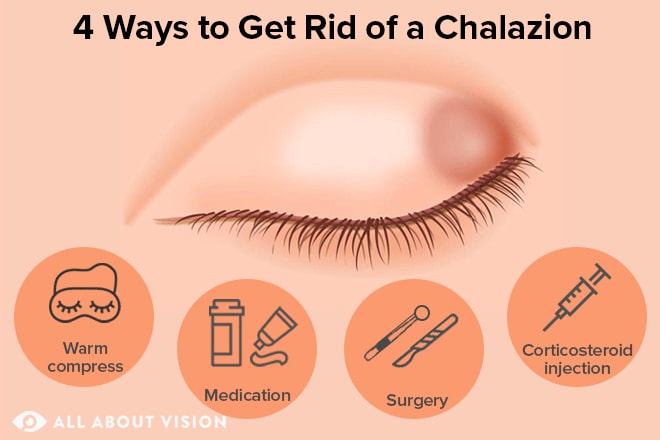
They may also prescribe lid scrubs as part of a daily eyelid hygiene routine. Like with many other conditions, the best “treatment” is prevention. Good eyelid hygiene is a key part of preventing these cysts.
If a chalazion is large enough to affect vision or doesn’t resolve after several weeks, the primary treatments are steroid injection and/or surgical removal.
The majority of meibomian cysts clear away on their own after two to eight weeks. It can be frustrating, but it’s best to wait and see if the cyst will heal naturally before turning to more invasive options.
Use a warm compress for at-home relief
Warm compresses are the most-frequently recommended at-home care for a chalazion. Applying warmth to the eyelid four to six times per day for 10 to 15 minutes can help soften the contents of the cyst. This allows it to heal more easily.
To be effective, a warm compress needs to maintain a temperature of around 113°F for at least 10 minutes. A cooler temperature won’t soften the cyst, and a hotter temperature could damage the eye’s surface. Plus, the heat from a warm compress takes about six minutes just to reach the affected gland.
Most common methods for making warm compresses at home do not meet these criteria. You can find pre-made options that work well at your doctor’s office and in drugstores, or you can use the “bundle method.”
The bundle method is a specific way to prepare an at-home warm compress. The end result stays warm long enough, so you don’t need to get up to reheat your compress every two minutes. Here is what you’ll need to do to follow the bundle method:
- Gather five to 10 washcloths and a microwave-safe bowl with a lid.
- Wet all the cloths with warm water and then wring them until just damp.
- Fold one washcloth in half lengthwise and then fold in half again.
- Fold the rest of the washcloths in half (but only once).
- Place the double-folded cloth at the bottom edge of the next cloth and roll them into a snug bundle.
- Roll this bundle into the next washcloth and so on until all the cloths are added.
- Put the bundle into the microwave-safe bowl and firmly seal the lid.
- Microwave for 1 minute 50 seconds. Leave the lid on and allow it to cool for 2 minutes.
- Remove the outermost layer of the bundle. Put the rest back in the bowl and cover with the lid.
- Use the first layer as your compress for 2 minutes. Replace your compress every 2 minutes with the next layer of the bundle until they’ve all been used.
Many eye doctors also recommend massaging the area for a few minutes a few times per day. This has to be done extremely gently and should never be confused with squeezing the cyst. It’s also important to note that massaging should never be done immediately after a warm compress. Doing so could seriously damage the cornea.
To massage a meibomian cyst, apply light pressure with a fingertip at the edge of the lump. Then slowly move your finger toward the lash line using consistent pressure. Always make sure to wash your hands first.
Medical treatments may include medication or surgery
As long as a meibomian cyst is asymptomatic, treatments are usually very conservative. In other words, warm compresses and lid massage are the best options unless the cyst is distorting vision, is infected or is recurrent.
In some cases, eye doctors may prescribe mild steroid eye drops and/or antibiotic eye drops. Both of these options will only help to relieve inflammation; they won’t work directly on the cyst. Steroid eye drops can also cause negative side effects for certain people, so doctors have to tailor treatment on a case-by-case basis.
A chalazion that becomes infected needs antibiotic treatment right away. Infections in the eyelid can spread and be very serious. Depending on the severity of the infection, oral or intravenous antibiotics are needed to prevent periorbital or orbital cellulitis.
Surgical removal and steroid injection are the main treatment methods for symptomatic or very persistent cysts. Eye doctors decide which method is the best option based on details unique to each case.
Chalazion surgery is done with a procedure called incision and curettage (I&C). This method is best for cysts that have softer consistencies, contain pus or may be infected. It’s also preferred for people with darker skin tones.
Recurrent meibomian cysts and cysts that can’t be definitively diagnosed should also be removed by I&C. In these cases, tissue samples may be sent for biopsy to rule out cancer and other types of tumors. Chalazia are always benign, but they can look and behave just like certain types of cancer.
An I&C is a simple in-office procedure. Your ophthalmologist or oculoplastic surgeon will numb your eyelid first by injecting a local anesthetic. Then they will use a small tool to evert the lid and hold it in place. The cyst is then removed through a small incision that won’t need stitches.
Steroid injection treatment is often preferred for chronic or very persistent cysts. It’s also best for cysts located near the tear canal and in cases with multiple cysts. Steroid injection is recommended for people who have had reactions to anesthetic in the past or who can’t take the antibiotics required after an I&C.
This is a quick in-office procedure. The doctor will give you numbing eye drops and then evert the lid to expose the chalazion. A steroid injection is given directly into the center of the cyst. For most patients, there is some pain and bruising in the area for a few days afterward.
Usually, the lump will be gone within a week or two after the injection, but some people need a second injection. If a second dose doesn’t help, it may need to be removed with an I&C.
Steroid injections do carry a risk of serious complications. In some people, they can cause skin depigmentation, tissue atrophy, increased intraocular pressure and vision loss. Your eye doctor will make sure this option is safe for you before recommending it.
I&C and steroid injection are both usually done from inside the eyelid. But sometimes, chalazia are so large that the eyelid can’t be everted. In these cases, both procedures can be done from the outside. An external I&C may leave a small scar.
Possible complications
Complications stemming from a chalazion are rare, but they are possible. In some cases, a persistent, untreated meibomian cyst can develop a secondary infection that leads to periorbital cellulitis. The risk for infection is greater if you squeeze or try to “pop” the cyst.
Other complications are usually due to improper or incomplete drainage of the meibomian cyst. These include:
- Eyelid scarring or “notching”
- Eyelash loss
- Eyelid fistula
- Skin changes at the inflamed site
Prevention
The best ways to prevent meibomian cysts are good hygiene and proper management of underlying conditions.
Make it a habit to wash your hands often, and always wash your hands before touching your eyes or contact lenses. Do your best to avoid touching your eyes unless it’s necessary. And wash your face with a cleanser and water every night before bed. Face washing is key, even for those who do not wear cosmetics.
Never share makeup or face products with others, and don’t use cosmetics or contact lenses past their expiration dates. These habits can introduce bacteria and many other types of germs to the eyes that cause inflammation and infection.
Managing any underlying conditions is also important in preventing chalazia.
Maintaining your target blood sugar and cholesterol can help keep recurrences under control. Avoiding things that trigger rosacea and dermatitis flare ups can also help. If you have inflammatory skin conditions like these, you can use diluted dandruff shampoo to wash your eyelids and eyelashes.
For those who have chronic blepharitis, it can be helpful to use a daily lid scrub. They are available over the counter in several formulas, and your eye doctor can recommend the best one for you. You can also make your own daily lid scrub with diluted baby shampoo.
Adding warm compresses and lid massage to your daily routine is also a good idea, especially for those who have MGD. These habits will help keep the eyelid glands from becoming blocked as often.
If you have recurrent chalazia or an eyelid lump that won’t go away, see your eye doctor. They’ll be able to determine what is causing the problem and the best way to treat it. An eye doctor can also help you figure out any undiagnosed or undertreated conditions that may be affecting your eyelids.
READ MORE about other kinds of eyelid bumps

